The Fate Of The Master And Margarita Is Decided
One of the most beautiful houses in Moscow
Bulgakov describes here the Pashkov House in Mokhovaya street in Moscow. It was built between 1784 and 1787, and was indeed about 150 years old when Bulgakov wrote his novel. The house was built at the slope of the Vagankovsky hill facing the Borovitsky gates for Peter Yegorovich Pashkov (1726-1790), who was a retired officer and the son of an orderly of czar Peter I (1672-1725). In 1812, the building was destroyed by a fire when Napoleon invaded Moscow. Later the building was acquired by the government. It was renovated and became a school for children of the nobility. After that it was the first public library which also appeared to be a real cultural centre for Moscow. Prominent Russian writers and scientists came here to study.
After that the Pashkov house became part of the Rumyantsev Museum, and Bulgakov visited it often in the 20s, when it had become the Lenin Library. Today it houses the manuscript collection of the State Library, including - appropriately - Bulgakov's archival manuscripts.
The building, designed by Vasily Ivanovich Bazhenov (1737-1799), is classical in style, with columns, urns, and terraces reminiscent of Rome. It had a garden with a pond, but that can’t be seen anymore. Today the house looks over a never ending car traffic stream.
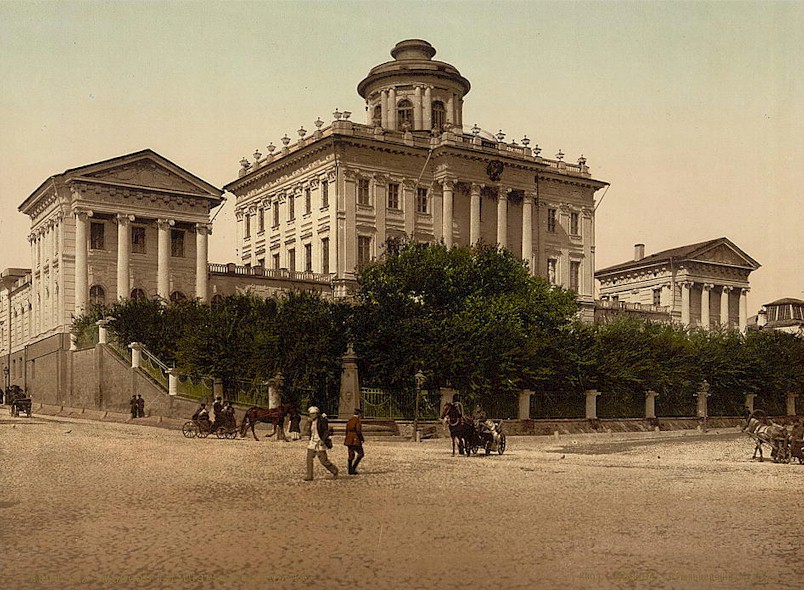
The Pashkov house
You can read more on the Pashkov house in the section Locations of the Master & Margarita website by clicking the arrow below.
A black soutane and a long and broad sword
The black soutane and the long and broad sword coincide with the uniform of a Knight of Kadosh or Knight of the white and the black eagle, the 30th degree in the Freemason lodge of the Ancient and Accepted Scottish Rite.
The interest of Bulgakov for Freemasonry can be explained by the fact that, in 1903, Afanasy Ivanovich Bulgakov (1859-1907), theologian and church historian, and the father of Mikhail Afanasievich, had written an article about Modern Freemasonry in its Relationship with the Church and the State, which was published in the Acts of the Theological Academy of Kiev.
In this article, the father of Bulgakov has described the initiation in the 30th degree of Knight of Kadosh.
You can read more on Freemasonry in The Master and Margarita in the Context section of the Master & Margarita website by clicking the arrow below.
Resting his sharp chin on his fist
Woland imitates in a very accurate way the pose of the statue the Thinker of the French sculptor Auguste Rodin (1840-1917). This statue is the central part of his famous work The Gates of Hell.
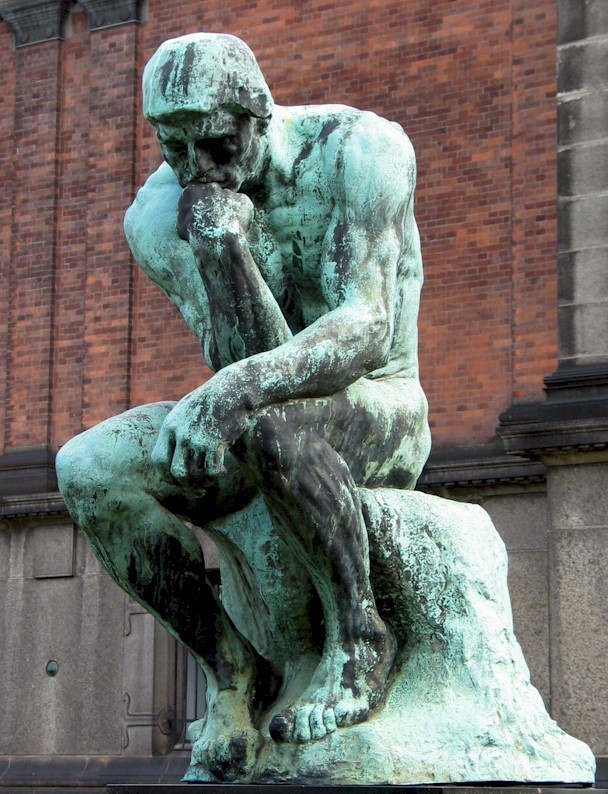
The Thinker by Auguste Rodin
You can read more on The Gates of Hell in the Themes, style and form section of the Master & Margarita website by clicking the arrow below.
Little hovels destined to be pulled down
From the roof of the Pashkov House, Woland could also see, between the palaces, the Храм Христа Спасителя [Khram Khrista Spasitelya] or The Cathedral of Christ the Saviour. You may think that this is not exactly a «little hovel destined to be pulled down», but maybe you should learn to now this cathedral’s story first.
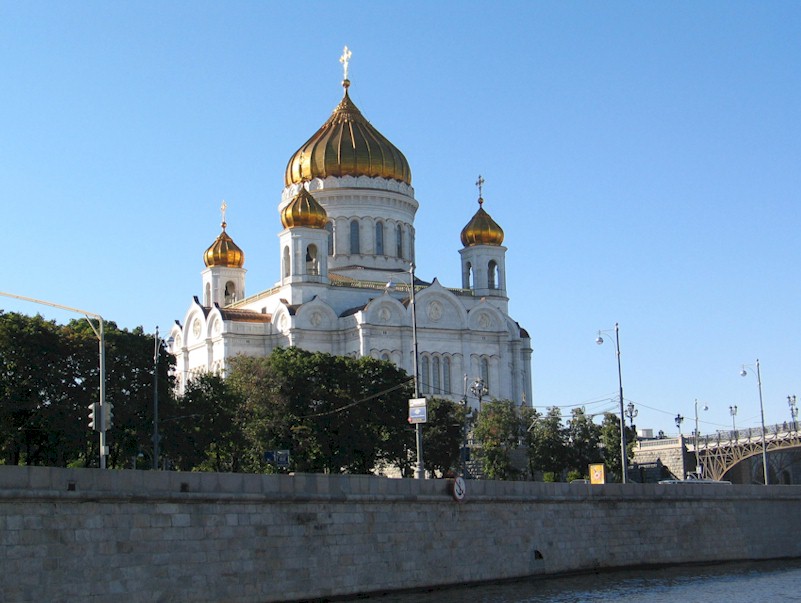
The Cathedral of Christ the Saviour
The story of the Cathedral of Christ the Saviour is worth to tell, if only it was to show the megalomania and the absurd ideas of Stalin.
After the Russian revolution, religion was officially abolished in the Soviet Union. The prominent position of the cathedral at the Moscow river embankment was a thorn in the flesh of Stalin, who had preferred a communist monument there. He organised a competition, to which participated, among others, famous architects like Charles-Édouard Jeanneret-Gris (1887-1965), who was better known as Le Corbusier and Walter Gropius (1883-1969). The first prize was for an American project resembling to the White House. But things went back to «normal» when, by the means of a «Special Prize of the Jury», Soviet citizen Boris Mikhailovich Iofan (1891-1976), who also had designed the House on the Embankment, was presented as the winner. His Palace of the Soviets was a skyscraper with a 100 meter high statue of Lenin on the top. The total height of the building should have been 415 meters, which would have made it the highest building in the world, even bigger than the Empire State Building. The arm that Lenin would stretch over Moscow would have been thirty meter.
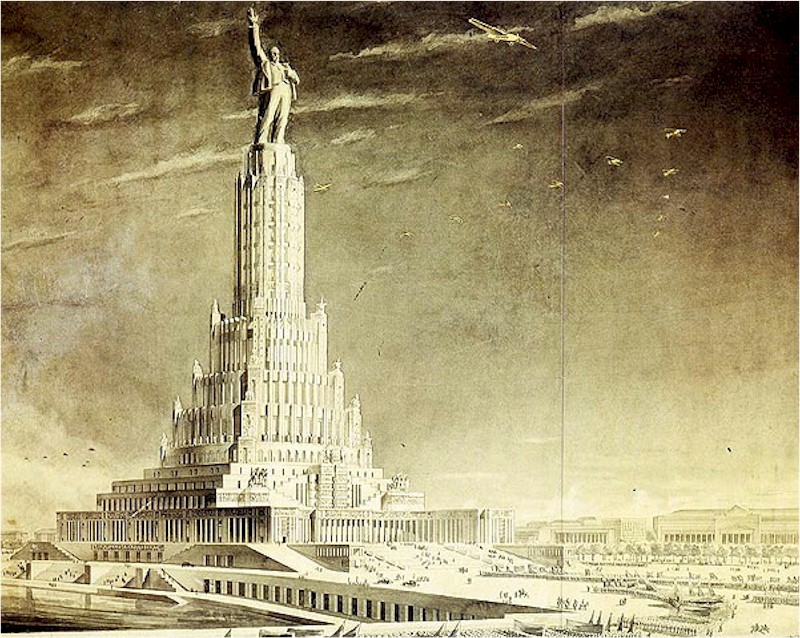
The Palace of the Soviets
In July, 1931 the demolition of the Cathedral started. The last pieces were blown up in December 1931. Some priests refusing to leave the Cathedral were killed for it. The writer Ilya Arnoldovich Faynzilberg (1897-1937), who formed the famous satirical writing partnership Ilf & Petrov together with Eugene Petrovich Kataev (1903-1942) - and admired by Bulgakov - was also an avid photographer. He witnessed the detonation of the cathedral and made photos of it.
Another witness of the destruction of the cathedral was Vladislav Vladislavovich Mikosha (1909-2004), who just started his career as a cameraman in 1931 and who made a film about it.
When the construction of the Palace of the Soviets started, it appeared that no one had thought of the proximity of the river. Too much water from the Moscow river seeped into the soil, which made it impossible to erect such building on that particular spot. Eventually the project was cancelled by Party Secretary Nikita Sergeevich Khrushchev (1894-1971) in 1953, and the excavation was transformed in 1958 into the huge Москва бассейн [Moskva basseyn] or Moscow pool, the world's largest open air swimming pool.
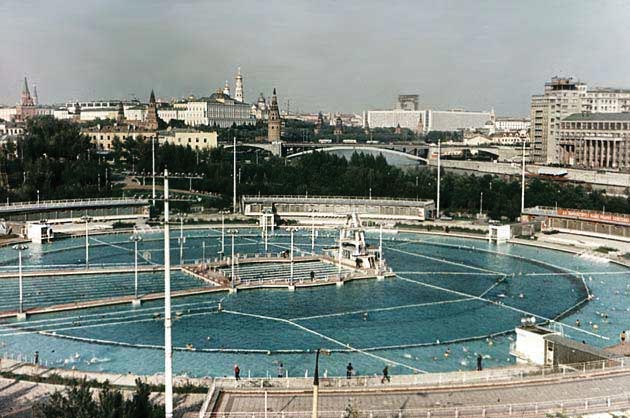
The Moscow pool
After the fall of communism, religion reinstated rapidly in Russia. In 1990, president Boris Nikolaevich Yeltsin (1931-2007) gave the permission to build a new cathedral following the original concept at the same location. In 1992, a fund was established for the reconstruction and the foundations were laid in 1994. The new cathedral would consist of two churches: the lower church, consecrated to the Saviour's Transfiguration, and the upper church. The lower church was inaugurated in 1996. The complete cathedral was inaugurated on August 19, 2000. In the basement, next to the lower church, there's a museum telling the story of the cathedral and the church's history in general.
I like Rome better
Woland and Azazello have their view over Moscow while Torgsin and Griboedov are on fire. It recalls how emperor Nero (37-68) had a view over Rome after he had put the city on fire himself in the year 64. Originally Bulgakov had planned for this to happen to Moscow as well in the novel.
He does not deserve the light, he deserves peace
Scholars disagree about the significance of the master's fate. Some consider that the master's fate is less than light because he does not persevere in his writing, he loses faith in himself. Others think peace for a creative writer may be no less a fate than light.
The Russian Bulgakov expert Boris Vadimovich Sokolov (°1957), the author of the Bulgakov Encyclopedia, associates this fate with Freemasonry, without giving much evidence. He argues that Freemasons are regarded as «children of light» and sees a link with the Faust by Johann Wolfgang Goethe (1749-1832). He does not specify which link, though.
For sure, Goethe was a prominent Freemason. On June 23, 1780, on the eve of the feast of John the Baptist, the most important holiday of the year for the German Freemasons, he joined Amalia, a Freemason Lodge in Weimar. He had asked asked not to be blindfolded on his initiation. He had promised on his word of honor that he would keep his eyes closed. Goethe wrote many poems on the occasion of Masonic events. In 1830, for example, he wrote Dem würdigen Bruderfeste: «Fünfzig Jahre sind vorüber», a poetic acceptance speech at his 50th anniversary as a Freemason.
The Belgian mathematician, professor of Logic and Philosophy of Science Jean Paul Van Bendegem (°1953), an eminent Freemason, says about the meaning of light: «The light plays a major role in Freemasonry. A new member receives 'the light' at his initiation, a ritual having its origins in the Enlightenment thinking. Masons, however, use the light also in the biblical sense. They are inspired by the Gospel of John: 'The light shines in the darkness, and the darkness has not overcome it'.»
If this statement is correct, the master would therefore have had no access to the «heavenly glory», so rest would be a lesser reward than light.
In 1991, the Russian literary critic Yevgeny Kanchukov wrote in his article Расслоение мастера [Rassloenie mastera] or The Layering of the Master, published in the literary magazine Литературное обозрение [Literaturnoe obozrenie] or Literary Review that peace was a kind of punishment for the master.
Kanchukov compared the destiny of Levi Matthew with the fate of the master. Levi resisted, committed opposition and continued to write, so he could therefore join Yeshua in the light. The master gave up, burned his manuscript and turned away from his novel. So he showed cowardice, «the most grievous vice», and therefore he did not deserve the light.
Timiriazev
Koroviev refers to the statue of the famous Russian botanist Kliment Arkadyevich Timiriazev (1843-1920) at Nikitsky Gates in Moscow.
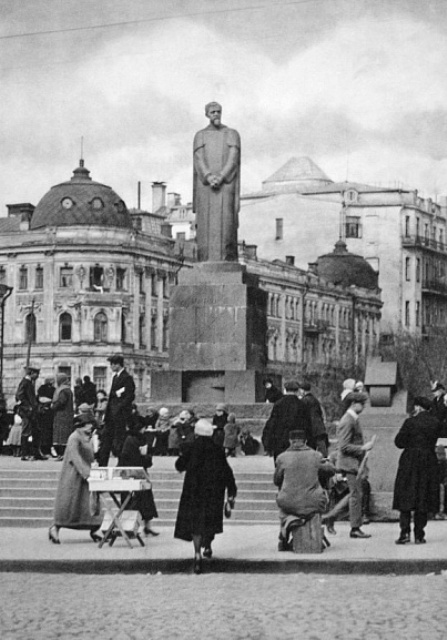
The statue of Timiriazev

